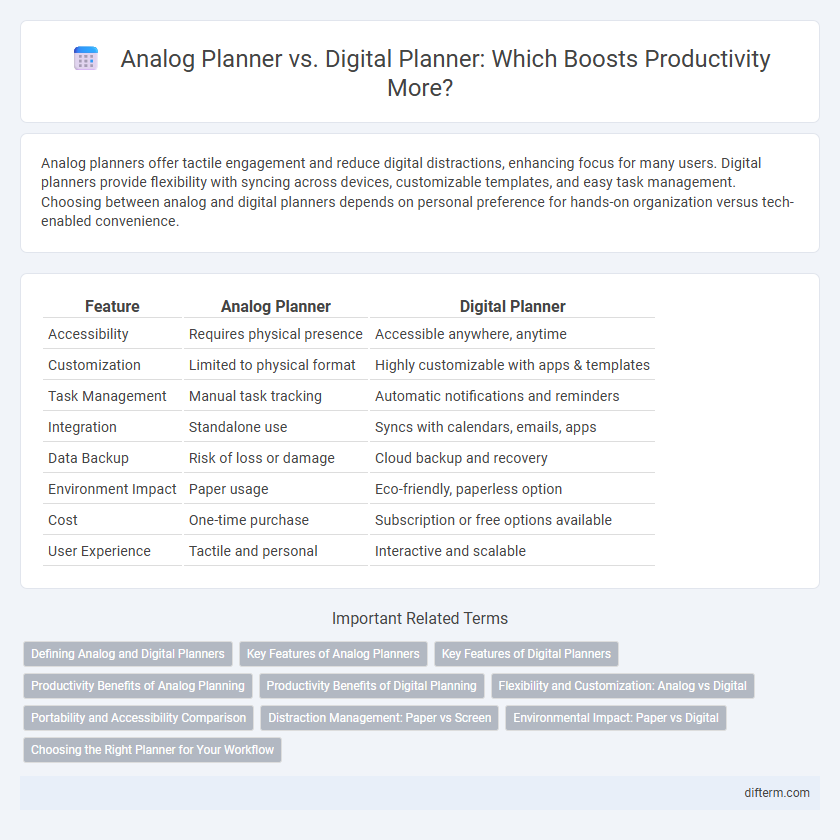Analog planners offer tactile engagement and reduce digital distractions, enhancing focus for many users. Digital planners provide flexibility with syncing across devices, customizable templates, and easy task management. Choosing between analog and digital planners depends on personal preference for hands-on organization versus tech-enabled convenience.
Table of Comparison
| Feature | Analog Planner | Digital Planner |
|---|---|---|
| Accessibility | Requires physical presence | Accessible anywhere, anytime |
| Customization | Limited to physical format | Highly customizable with apps & templates |
| Task Management | Manual task tracking | Automatic notifications and reminders |
| Integration | Standalone use | Syncs with calendars, emails, apps |
| Data Backup | Risk of loss or damage | Cloud backup and recovery |
| Environment Impact | Paper usage | Eco-friendly, paperless option |
| Cost | One-time purchase | Subscription or free options available |
| User Experience | Tactile and personal | Interactive and scalable |
Defining Analog and Digital Planners
Analog planners are traditional, physical diaries or notebooks used for organizing tasks, appointments, and goals through handwritten notes, fostering tactile engagement and minimizing digital distractions. Digital planners operate on electronic devices via apps or software, offering features like cloud synchronization, reminders, and customizable templates to streamline productivity across multiple platforms. Selecting between analog and digital planners depends on personal preferences for accessibility, flexibility, and interaction with planning tools.
Key Features of Analog Planners
Analog planners offer tactile engagement through handwritten notes, enhancing memory retention and focus. Key features include customizable layouts, customizable sections for goal-setting, and paper quality that supports various writing instruments. The absence of digital distractions allows users to maintain a clear workflow and improve time management.
Key Features of Digital Planners
Digital planners offer seamless synchronization across multiple devices, enabling users to access and update their schedules in real-time. Features like customizable templates, interactive calendars, and integrated task management boost productivity by providing tailored organization. Automated reminders and cloud storage ensure tasks and notes are secure and consistently accessible, enhancing efficiency over traditional analog planners.
Productivity Benefits of Analog Planning
Analog planning enhances productivity by minimizing digital distractions, allowing focused attention on tasks. The tactile experience of writing on paper reinforces memory retention and prioritization, leading to better task management. Handwritten planners also encourage intentional scheduling, which fosters deeper commitment to goals and deadlines.
Productivity Benefits of Digital Planning
Digital planners enhance productivity by offering seamless synchronization across devices, enabling real-time updates and accessibility from anywhere. Features like customizable templates, task prioritization, and automated reminders optimize time management and reduce the risk of missed deadlines. Integration with apps such as calendars, emails, and project management tools streamlines workflows, boosting overall efficiency compared to analog planners.
Flexibility and Customization: Analog vs Digital
Analog planners offer tactile customization through handwritten notes and physical inserts, enabling flexible layout adjustments and personal creativity. Digital planners provide advanced flexibility with features like drag-and-drop organization, customizable templates, and seamless integration across devices for real-time updates. The choice between analog and digital hinges on user preference for tangible interaction versus dynamic, scalable customization options.
Portability and Accessibility Comparison
Analog planners offer tactile control and do not require battery power, making them easily accessible in any environment without dependence on technology. Digital planners provide enhanced portability through synchronization across multiple devices, enabling seamless access and real-time updates anywhere with internet connectivity. Users choosing between analog and digital planners must weigh the convenience of offline use against the flexibility of cloud-based accessibility.
Distraction Management: Paper vs Screen
Analog planners minimize digital distractions by eliminating app notifications and screen alerts, fostering deeper focus on tasks. Paper planners promote tactile engagement, which can enhance memory retention and reduce cognitive overload compared to digital screens. Digital planners offer customizable alerts but risk frequent interruptions, making distraction management more challenging without disciplined usage.
Environmental Impact: Paper vs Digital
Analog planners consume paper, contributing to deforestation and waste, while digital planners reduce paper usage but increase energy consumption due to the need for electronic devices and data storage. The environmental impact of analog planners includes landfill contributions and carbon emissions from paper production, whereas digital planners rely on electricity and electronic waste management. Choosing between analog and digital planners involves balancing physical resource consumption with energy use and e-waste generation to minimize overall environmental footprint.
Choosing the Right Planner for Your Workflow
Choosing the right planner depends on your workflow preferences and productivity goals. Analog planners offer tactile engagement and fewer distractions, ideal for those who benefit from handwriting and visual organization. Digital planners provide flexibility, easy editing, and integration with apps, perfect for users who manage schedules across multiple devices and require real-time updates.
Analog planner vs digital planner Infographic

 difterm.com
difterm.com